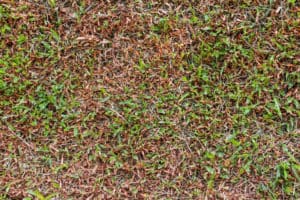
Why Is My Grass Turning Brown?
When you’ve spent your hard-earned cash and precious time laying and caring for a new lawn, brown spots can seem like the end of the world. Pinpointing the cause of the browning is the only way to remedy it before it takes over your entire lawn.
Extreme heat
The most common cause of browning grass here in Florida is extreme heat. The temperatures here can soar above 100°F in the summer and stay well above 70°F all year long. Prolonged periods of high temperatures, especially when paired with drought conditions, can leave any lawn dried out and dull. Some grass varieties will even go dormant in excess heat.
If you suspect extreme heat is the cause of your lawn’s browning, make sure it is getting a uniform ⅔ inch of water on your designated watering days, preferably first thing in the morning, to prevent scorching.
Imbalanced chemistry
Your soil must have the correct chemical balance to sustain healthy grass growth. Fortunately, home soil tests are readily available at most garden centers and home improvement stores. You can also get assistance testing your soil at your county’s local extension office. A quick soil test will give you insight as to its pH along with levels of nitrogen, phosphorus, and potassium. Once you know your soil’s chemistry, you can make necessary adjustments so that it is as hospitable as possible for your grass.
Misaligned watering system
If you notice brown areas at the outer perimeter of your lawn where your sprinkler system may not adequately reach, try making adjustments so that your entire lawn is covered. You may need to consult with a professional lawn care company to make the necessary corrections.
Weeds
Invasive weeds can compete with your grass for nutrients and water, leaving you with brown patches around weed growth. Fight back with a selective herbicide sprayed on just offending weeds, or if your lawn is well-established, prevent weeds altogether with a pre-emergent herbicide in the spring and fall.
Disease
All sorts of diseases can affect your lawn, leaving spots of all colors, from brown to black to even orange! Mold, fungus, and other diseases will require expert identification and treatment, so if you suspect disease as the issue, contact a professional lawn care company for assistance.
Infestations
Bug infestations are another common cause of brown spots in your lawn; chinch bugs are of particular concern for causing discolorations. Inspect the border between the brown and green grass for the adult chinch bug, which is black and white. If you find chinch bugs, contact a professional pest control company for treatment.
Pet waste
Have you noticed small, round spots in your lawn near areas where you know your pets use the restroom? These are most likely caused by the extra acidic urine your pets are leaving behind. Simply redirect your pets to another area of the lawn, preferably one without grass, to alleviate this issue.
Is your grass too far gone?
Any of these issues can cause lawn death if not identified and corrected in time. To see if your lawn has passed the point of no return, give it the tug test. Dead grass will pull up quite easily, while grass with life left in it will resist releasing from the soil.
Sod for sale in Tampa Bay
If you need new sod to repair patches in your lawn or to replace the entire thing, contact Council Growers Sod at (813) 633-8665 or order sod online. We’ll deliver your choice of sod variety directly from our fields to your door, ensuring it is the freshest and healthiest sod possible for your project!


